I’m getting ready for another Mexican road trip. You may recall my last road trip, to see the Pueblos Mágicos in Zacatecas and Aguascalientes. This time I’ll be hitting the states of Querétaro, San Luis Potosí, and Guanajuato, and there are twenty Pueblos Mágicos on the itinerary. And Luis and Taco will both be along for the ride.
I’m sharing our itinerary here, but mostly I’m using this post to do the research so we know what to look for in each town and along the route.
Since we’ll have Taco with us, we’ll concentrate on outdoor sights, but there are a few museums that I hope we’ll be able to poke into.
Too many Pueblos Mágicos!
When I first moved to Mexico in 2019, there were 122 Pueblos Mágicos across the country. I thought it would be fun to try to visit as many of them as I could.
Today there are 177. And more will likely be added in the years ahead.
I’m giving up on my goal to see them all. I’ll just enjoy seeing the ones I can.
Day One
We start out on day one in the wrong direction, heading west so we can go around the lake to our first stop.
Jiquilpan
Jiquilpan is actually in Michoacán, but I decided to include it on this trip because it’s not too far and more-or-less on the way (minus the initial diversion to the west). The name of the town comes from Nahuatl and means “indigo place.” Among its claims to fame, Lázaro Cárdenas del Río, Mexican president from 1934 to 1940, was born in Jiquilpan. (There’s a calle named for him in just about every city and town in Mexico, including Ajijic; in Guadalajara, one of the main thoroughfares through the city is named for him.) Jiquilpan became a Pueblo Mágico in 2012.
Here are some sights we might visit in Jiquilpan:
- Jardín Colón and Fuente de la Aguadora
- Iglesia San Francisco de Asís
- Glorieta de los Gallitos
- Casa y Museo Lázaro Cárdenas, the house where he was born
- Murals by José Clemente Orozco, who lived in Jiquilpan for a time, in the public library and in a school
- Bosque Cuauhtémoc and Casa de Piedra (Stone House).
www.sectur.gob.mx/gobmx/pueblos-magicos/jiquilpan-michoacan/
programadestinosmexico.com/pueblos-magicos/jiquilpan.html
www.turimexico.com/pueblos-magicos/pueblo-magico-jiquilpan-michoacan/
Salvatierra
Our first overnight will be in Salvatierra, which became a Pueblo Mágico in 2012. Located in the Huatzindeo Valley of southern Guanajuato, Salvatierra is known for its architecture, with mansions, haciendas, convents, and several beautiful bridges across the Río Lerma. So it’s supposed to be a nice town to just wander about.
There are a few churches supposedly worth visiting:
- Santuario Diocesano de Nuestra Señora de la Luz
- Templo y Convento de las Capuchinas
- Convento de San Francisco
We’ll be staying the night at this Airbnb.
pueblosmagicos.mexicodesconocido.com.mx/guanajuato/salvatierra/
www.turimexico.com/pueblos-magicos/pueblo-magico-salvatierra-guanajuato/
Day Two
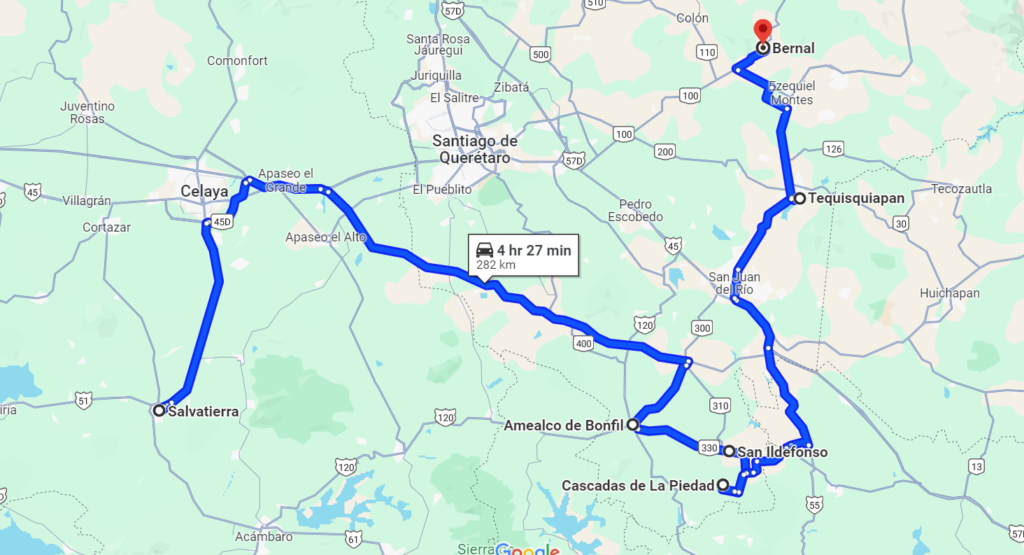
Amealco de Bonfil
We arrive in the state of Querétaro today for the first three of our eight Pueblos Mágicos here. Amealco, which became a magical town in 2018, is probably more known for its surroundings, but we will probably make a quick stop in town to see the Plaza de la Constitución and Parroquia Santa María (and to take a selfie in front of the letras. Amealco is also famous for the dolls crafted by local Otomi women. The Museo de la Muñeca Artesanal is a possible stop if time allows.
Nearby are the ruins at San Ildefonso, and the waterfall at La Piedad, so we will try to make those stops before moving on.
www.gob.mx/sectur/articulos/amealco-de-bonfil-queretaro
pueblosmagicos.mexicodesconocido.com.mx/queretaro/amealco/
Tequisquiapan
Our next stop, Tequisquiapan, has been a Pueblo Mágico since 2012. It is well known for its Wine and Cheese festival, held in May and June. Since we’ll be there in January, we will probably make a quick stop here to see the main square, Plaza Manuel Hidalgo, and the Templo Parroquial Santa María de la Asunción. The town is supposed to have colorful streets, so we’ll probably wander a bit, and we’ll visit Parque “La Pila.” There’s also an artisan market with some handcrafted stuff.
www.tequisquiapanpueblomagico.com.mx/
www.gob.mx/sectur/articulos/tequisquiapan-queretaro
Bernal
When I first read about Bernal, that’s when I decided I needed to take a road trip to Querétaro. The area’s claim to fame is the Peña de Bernal, the third tallest monolith in the world (after the Rock of Gibraltar and Sugarloaf Mountain in Rio de Janeiro). Towering 433 meters (1420 feet) above the town, it is believed to be about 65 million years old, formed by an extinct volcano that eroded away, leaving a core of solidified lava.
The town of Bernal was named Pueblo Mágico in 2005. In addition to the Peña, it is supposed to be a very colorful town filled with interesting architecture. Here are some of the sights:
- Capilla de las Ánimas
- Capilla de la Santa Cruz
- El Baratillo
- El Castillo
- Museo de la Máscara
- Templo de San Sebastián Mártir
And we spend the night in Bernal at the Hotel Alborada.
pueblosmagicos.mexicodesconocido.com.mx/queretaro/bernal/
www.gob.mx/sectur/articulos/bernal-queretaro
Day Three
Cadereyta de Montes

Our first stop on Day Three is just a short drive from Bernal. Cadereyta was named a Pueblo Mágico in 2011, primarily for its colonial architecture, but also because larger municipality of the same name (which includes the small town we’re visiting) is in the transition zone between semi-desert to the south and the Sierra Gorda to the north. The town is in the southern part of the municipality and sits in the semi-desert. (As you can see from the map, we’ll be heading north to the Sierra Gorda after we leave Cadereyta.)
We’ll visit some of the churches and wander the streets for a bit here. There’s also a Jardín Botánico on the edge of town, and La Quinta Fernando Schmoll, a greenhouse dedicated to the conservation, knowledge, and reproduction of cacti and succulents. So depending on time, maybe we’ll check out those sights.
www.sectur.gob.mx/gobmx/pueblos-magicos/cadereyta-de-montes-queretaro/
queretaro.travel/lugares/cadereyta-de-montes/
www.de-paseo.com/queretaro/item/cadereyta-de-montes/
San Joaquín
When we reach San Joaquín, we will be in the Sierra Gorda region. So I expect a significant change in topography on the drive from Cadereyta.
San Joaquín was named a Pueblo Mágico in 2015. It sits at 1,700 meters (5,577 feet) altitude surrounded by mountains covered in pine and oak trees. Originally a mining town, today San Joaquín is known as the cultural center for Huapango, a traditional folk music and dance style. (The annual Huapango festival is held in April, so we won’t be there for that, but if we’re lucky, maybe we’ll get to hear and see some.)
Sights to see in San Joaquín:
- Iglesia Parroquial
- Gruta de los Herrera, an underground cave system that we might not be able to go to because of Luis’s claustrophobia, or because dogs aren’t allowed
- Mercado Municipal
- Mirador de San Joaquín
Not too much of interest in town, it seems. But I think the main highlight is the Zona arqueológica de Ranas y Toluquilla, 3 km outside town, which some describe as the Machu Picchu of Mexico. (Luis and I have both been to the actual Machu Picchu, so maybe this won’t be so impressive for us.)
www.gob.mx/sectur/articulos/san-joaquin-queretaro
queretaro.travel/lugares/san-joaquin/
Pinal de Amoles

To get to Pinal de Amoles from San Joaquín, we have to backtrack about 33 km, including the twisty stretch of road above. Plus there’s a lot more similar twists and turns much of the way.
As we approach the town, we’ll pass through Puerta del Cielo (Gate of Heaven), the highest point on the road leading into Pinal de Amoles, with a view to the town and, often in winter, its mar de niebla (sea of fog).
Pinal de Amoles is the one stop on our road trip where we will stay for two nights. For this is in the heart of the Sierra Gorda. In fact, Pinal de Amoles is located with the Reserva de la Biosfera Sierra Gorda, a conservation area that takes up 383,567 hectares (1,481 square miles), about 32% of the land area in the state of Querétaro.
The town itself, which was just named a Pueblo Mágico earlier this year, is small and probably just a stopping point. It’s really about exploring the surrounding mountains, finding viewpoints, waterfalls, and caves.
We’re staying in an Airbnb in the heart of the town.
pueblosmagicos.mexicodesconocido.com.mx/queretaro/pinal-de-amoles/
pinaldeamolespueblomagico.travel/
Day Four
This is our day to explore the Sierra Gorda. Here are some of the recommended places to se:
- Mirador Cuatro Palos (viewpoint)
- Cascada El Chuveje (waterfall)
- Puente de Dios (Bridge of God)
- Cascada El Salto (waterfall)
- Cañón del Infiernillo (canyon)
- Misión de Bucareli
- Cueva del Judío (Cave of the Jew)
- Cueva de los Riscos (Cave of the Cliffs)
- Cañón de la Angostura (Canyon of the Angostura)
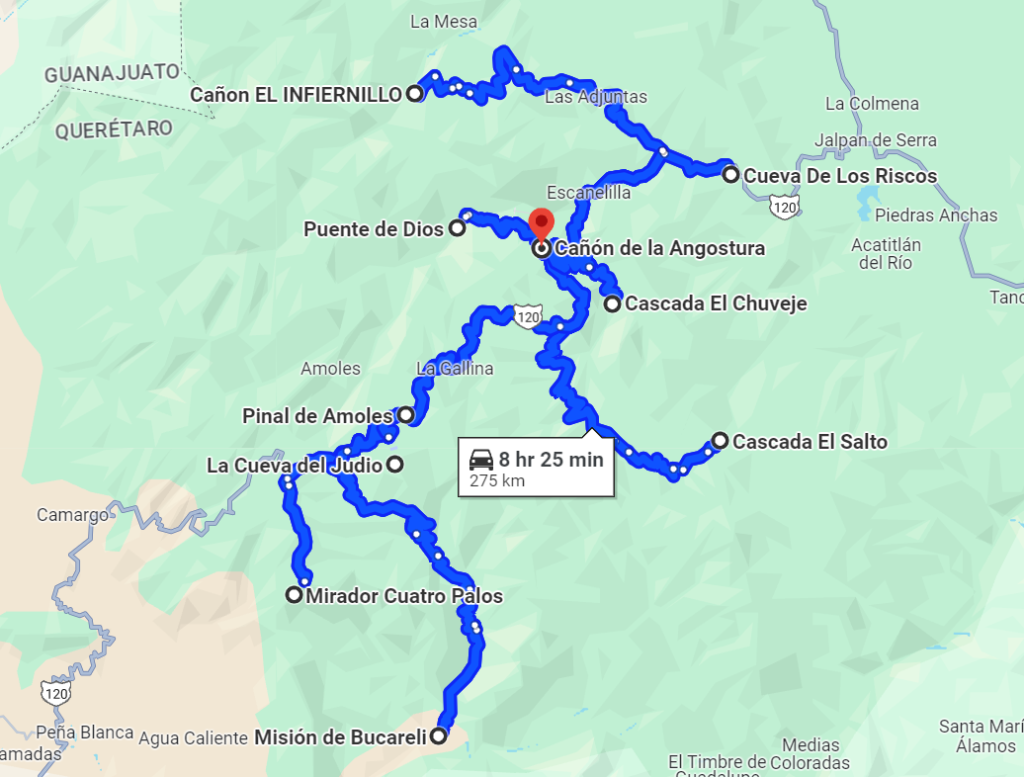
Day Five
Jalpan de Serra
We start Day Five with a drive to Jalpan de Serra, another town within Reserva de la Biosfera Sierra Gorda just about 40 km from Pinal de Amoles. Jalpan has been a Pueblo Mágico since 2010. My sense is that the town itself has more to offer in terms of culture than Pinal de Amoles, but that doesn’t necessarily mean it’s nicer. I guess we’ll find out.
Two Franciscan missions are located in the town: Santiago de Jalpan and Nuestra Señora de la Luz de Tancoyol. These are two of five eighteenth-century Franciscan Missions in the Sierra Gorda which are UNESCO World Heritage sites. These were founded by Junipero Serra, who also founded 8 of the 21 Spanish missions in California, and whose mission work is seen as highly controversial for the forced conversion and mistreatment of native peoples.
Just outside Jalpan, a dam in the Río Jalpan created a lake that is a home to many migratory birds, and a malécon runs alongside the lake. And there is a historical museum in town, the Museo Histórico de la Sierra Gorda. So probably more things to see and do in the short time we’ll have to stop here.
www.gob.mx/sectur/es/articulos/jalpan-de-serra-queretaro
queretaro.travel/lugares/jalpan-de-serra/
www.lugaresturisticosenmexico.com/jalpan-de-serra-queretaro-pueblo-magico/
Xilitla
After leaving Jalpan, we continue through the Sierra Gorda before crossing out of Querétaro and into San Luis Potosí. (San Luis Potosí gets its name from Louis IX of France and from Potosí, Bolivia, a wealthy silver mining town whose riches this region of Mexico aspired to but never attained.)
Xilitla, our first stop in San Luis Potosí, has been a Pueblo Mágico since 2011. There are several things worth checking out in the town: the main plaza with the Ex convento de San Agustín, dating from the mid-16th century, and a number of caves and waterfalls.
The top attraction here, though, is Las Pozas (The Pools), a short drive outside of the town. This is a garden of natural waterfalls and pools interlaced with surrealistic sculptures. Las Pozas was created by Edward James (1907–1984), a British poet and lover of surrealist art.
In the town is a museum dedicated to Edward James, and another with the art of Leonora Carrington (1917–2011), a British sculptor who lived most of her adult life in Mexico and who was a leader of Mexico’s women’s liberation movement.
www.gob.mx/sectur/articulos/xilitla-san-luis-potosi
programadestinosmexico.com/pueblos-magicos/xilitla.html
Aquismón
What the Sierra Gorda is to Querétaro, Huasteca Potosina is to San Luis Potosí. And Aquismón, which was named Pueblo Mágico in 2018, is one of the main towns in this region, as is Xilitla.
The Huastec civilization was an offshoot of the Mayans, and they settled in a broad area of what is now northeastern Mexico around the 10th century. The portion of their lands now within the state of San Luis Potosí is called the Huasteca Potosina. The Aztec empire conquered them in the 15th century.
The top attractions of this region are the many waterfalls, caves, canyons, and caverns. I don’t know how easy they are to get to by car or how much hiking is involved, so we may not get to see many of them.

We may just make a quick stop in Aquismón, since it seems the main attractions are outside the town. We are staying the night in an Airbnb about 12 km north of the town. This might make it more convenient to visit some of the sights. Or maybe not.
www.gob.mx/sectur/articulos/aquismon-san-luis-potosi
pueblosmagicos.mexicodesconocido.com.mx/san-luis-potosi/aquismon/
Day Six
Ciudad del Maíz
One of the 45 new Pueblos Mágicos named in 2023, Ciudad del Maíz (Corn City), there are some things to see here, as well as in the surrounding area. But because we have a long drive, we may keep this to a quick lunch stop: there’s a local dish called Guiso Barracho (Drunken Stew) that we might want to try.
But here are some of the buildings in town that are supposed to be worth checking out:
- Casa Barragueña, and old house converted to the City Hall
- Casa de la Cultura
- Templo de la Purísima Concepción
- Iglesia Presbiteriana, one of the oldest non-Catholic temples in Mexico
Local crafts are popular here too. Considering the name of the town, it’s no surprise that corn husks are a common material for making dolls and other small objects.
pueblosmagicos.mexicodesconocido.com.mx/san-luis-potosi/ciudad-del-maiz/
escapadas.mexicodesconocido.com.mx/san-luis-potosi/ciudad-del-maiz/
www.liderempresarial.com/que-hacer-en-ciudad-del-maiz-nuevo-pueblo-magico-de-slp/
Real de Catorce
One of the original Pueblos Mágicos designated in 2001, Real de Catorce is a long way from all the other places we’re visiting on our road trip. I almost decided to skip it, but everything I’ve read about it tells me it’s a fascinating town worth visiting.
I’ve read that Real de Catorce is a ghost town. Once a thriving silver mining community, it is certainly a remnant of an earlier time, with rustic houses, old cars, and cobbled streets. The route into town is through the Tunél Ogarrio, a 2.3‑km tunnel that opened in 1901. Just a single lane wide, traffic can only flow one direction at a time.
Among the things to see in Real de Catorce are
- Antigua Casa de la Moneda (the old mint)
- Parroquia de la Purísima Concepción
- Parroquia de San Francisco de Asis
- Plaza Hidalgo
But they say just getting lost in the maze of cobbled streets is the town’s number-one activity.
We’re staying the night here at this boutique hotel (via Airbnb).
www.gob.mx/sectur/es/articulos/real-de-catorce-san-luis-potosi
visitasanluispotosi.com/real-de-catorce/
www.mexicodesconocido.com.mx/que-hacer-en-real-de-catorce.html
Day Seven

We start out our drive today with a bit of backtracking, about 2 hours worth. I sure hope Real de Catorce was worth going so far out of our way.
Santa María del Río
We bypass the city of San Luis Potosí before arriving at our first stop, Santa Maria del Río, which became a Pueblo Mágico in 2020. The town is famous for rebozos, long, flat shawl-like garments worn by Mexican women. As their popularity has diminished, Santa Maria del Río is one of the only places in the country where high-quality rebozos are still made. The Museo Casa del Rebozo sits right on the main plaza, Jardin Hidalgo.
Other sights include the Parroquia de Nuestra Señora de la Asunción and the Reloj Bicentenario, a clock tower erected in 2010, the 200th anniversary of Mexican independence.
www.gob.mx/sectur/articulos/santa-maria-del-rio-san-luis-potosi
pueblosmagicos.mexicodesconocido.com.mx/san-luis-potosi/santa-maria-del-rio/
www.lugaresturisticosenmexico.com/santa-maria-del-rio-san-luis-potosi-pueblo-magico/
Tierra Nueva

Just a short drive from Santa Maria del Río, we arrive at Tierra Nueva, another of the new Pueblos Mágicos designated in 2023.
Tierra Nueva is known as a center for various crafts including pottery and palm hats. And nearby is the Presa La Muñeca, a reservoir that might be worth a side trip.
pueblosmagicos.mexicodesconocido.com.mx/san-luis-potosi/tierra-nueva/
www.elsoldesanluis.com.mx/local/conoce-tierra-nueva-un-pueblo-magico-de-artesanos-10297156.html
Mineral de Pozos
After leaving Tierra Nueva, we cross back into Guanajuato state, and we come to Mineral de Pozos, a Pueblo Mágico since 2012.
This town is known largely for its abandoned mines and haciendas, remnants of its heyday as a mining town. Twice in its history, Mineral de Pozos was abandoned, but tourism has brought it back to popularity today. The nearby Mina Cinco Señores and Ex-Hacienda Santa Brigida are two of the top sights I’m looking forward to visiting.
In the town itself are the Jardin Juarez, Plaza Zaragoza, and Parroquia de San Pedro Apóstol. But I think the main draws to visiting here are not in the town.
We’re spending the night in an Airbnb that’s described as a “superadobe house.”
www.gob.mx/sectur/articulos/mineral-de-pozos-guanajuato
pueblosmagicos.mexicodesconocido.com.mx/guanajuato/mineral-de-pozos/
Day Eight
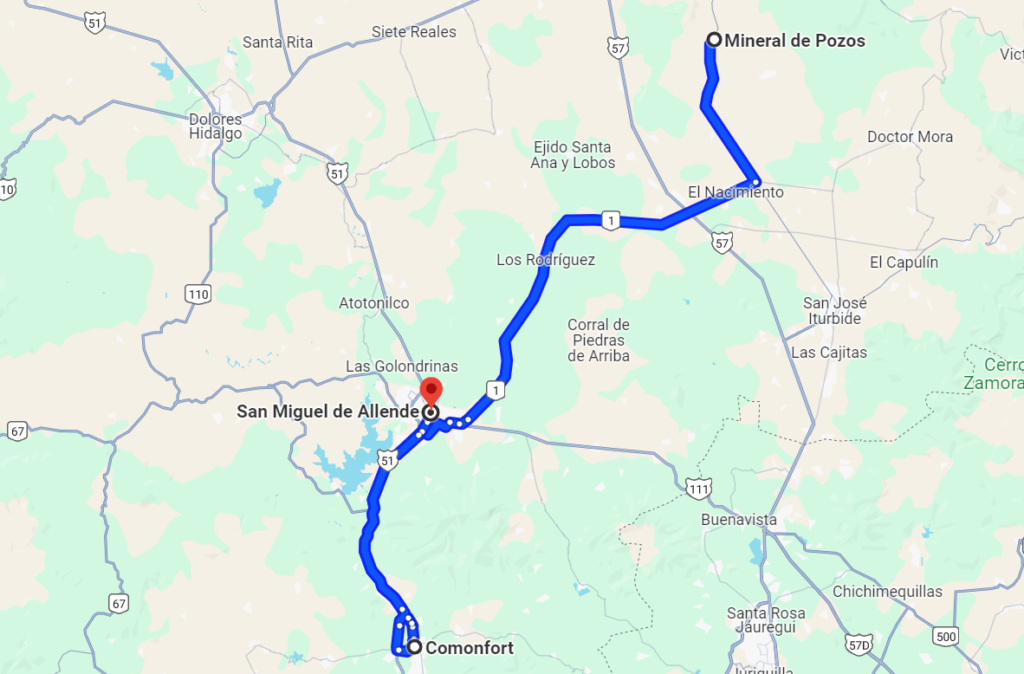
Comonfort
The namesake of Comonfort is Ignacio Comonfort, Mexican President for two years in the 1850s. The town became a Pueblo Mágico in 2018. It is known for molcajetes, artisanal stone mortars or bowls used, together with a tejolote (pestle) mainly to grind peppers and other spices, and to make salsas and guacamole. Today you can find molcajetes used to serve a dish by the same name all over Mexico. The dish varies regionally, but it’s essentially a stew of meats, seafood, vegetables, and spices, sometimes with cheese or beans. We might visit a molcajete workshop.
In addition to exploring the historic center of town, we’ll probably climb the Cerro de los Remedios, where we will find the remnants of ancient pyramids, an 18th-century temple, and a viewpoint.
www.gob.mx/sectur/articulos/comonfort-guanajuato
San Miguel de Allende
We have to backtrack again to head to San Miguel, the only stop on our adventure that is not a Pueblo Mágico. (It used to be, but then it was named a UNESCO World Heritage Site and dropped from the Pueblo Mágico program. In fact, it is probably too special to be a Pueblo Mágico: Travel & Leisure named it World’s Best City in 2017, 2018, and 2021 — for 2023 it’s dropped to #5 on the list — and Conde Nast Traveler named it to its top ten World’s Best Small Cities three years in a row in 2021, 2022, and 2023.)
I visited San Miguel earlier this year for a bridge tournament, but I wanted to bring Luis to this charming and beautiful place. It’s really a treasure trove of lovely, historic plazas and edifices. I can’t pick out any particular highlights, but everything centers around the Jardin Allende, the city’s main plaza. Our hotel, the Suites Santo Domingo, is a few short blocks away. We’ll stay here just one night, which isn’t enough, but we’ll enjoy every moment of it.
www.cultura.gob.mx/turismocultural/destino_mes/san_miguel/index.html
Day Nine
I’m thinking we might spend the morning in San Miguel before we leave for our next destinations. There’s just too much to see to squeeze it all in on Day Eight.
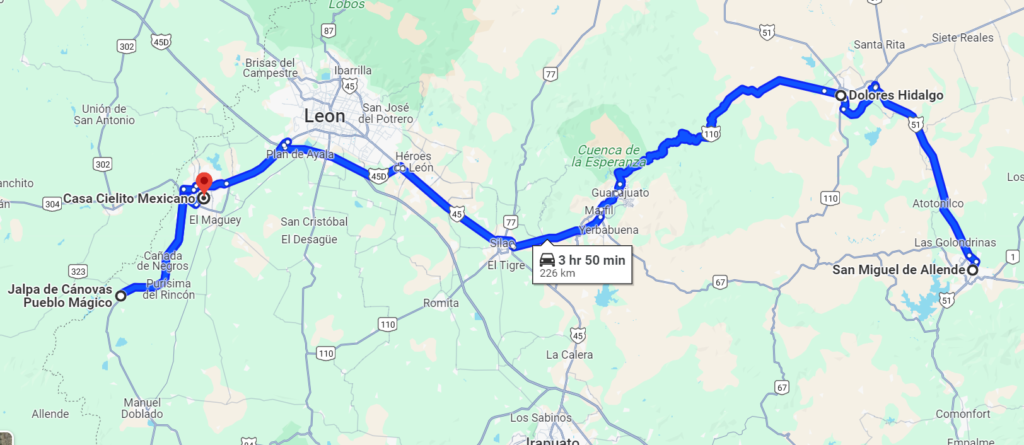
Dolores Hidalgo
This town is of major importance in Mexican history. In fact, the full official name is Dolores Hidalgo Cuna de la Independencia Nacional (Dolores Hidalgo, Birthplace of National Independence). It was named Pueblo Mágico in 2002.
The city was a small town known simply as Dolores when Father Miguel Hidalgo y Costilla uttered his famous cry for the independence of Mexico (the Grito de Dolores) there in the early hours of September 16, 1810, in front of Nuestra Señora de los Dolores parish church. After Mexico achieved independence, the town was renamed Dolores Hidalgo in his honor.
Wikipedia
We’ll surely visit the church, which stands across from the Plaza Principal. And nearby are three museums, the Museo del Bicentenario, the Museo de la Independencia Nacional, and the Museo de Sitio Casa de Hidalgo.
Dolores Hidalgo is also a center for ceramics, and since that’s one of my favorite forms of handcraft, I’m hoping to see some and maybe buy something. And the great singer/songwriter José Alfredo Jiménez (1926–1973) was born in Dolores Hidalgo; the Casa Museo José Alfredo Jiménez is another possible stop.
www.gob.mx/sectur/articulos/dolores-hidalgo-guanajuato
www.cultura.gob.mx/turismocultural/destino_mes/guanajuato/dolores.html
Jalpa de Cánovas
Jalpa de Cánovas started in the mid-16th century as a hacienda, was a cattle ranch, and became the estate of the Cánovas family. We should be able to visit the gardens, aqueduct, and mill, plus other remnants of the estate.
Jalpa became a Pueblo Mágico in 2012.
Depending on timing, we may save Jalpa for the morning of Day Ten. We’re actually staying in a small hotel, Casa Cielito Mexicano, in San Francisco del Rincón, about 30 km away. (I was unable to find any lodging in Jalpa.)
www.gob.mx/sectur/articulos/jalpa-guanajuato
pueblosmagicos.mexicodesconocido.com.mx/guanajuato/jalpa-de-canovas/
Day Ten
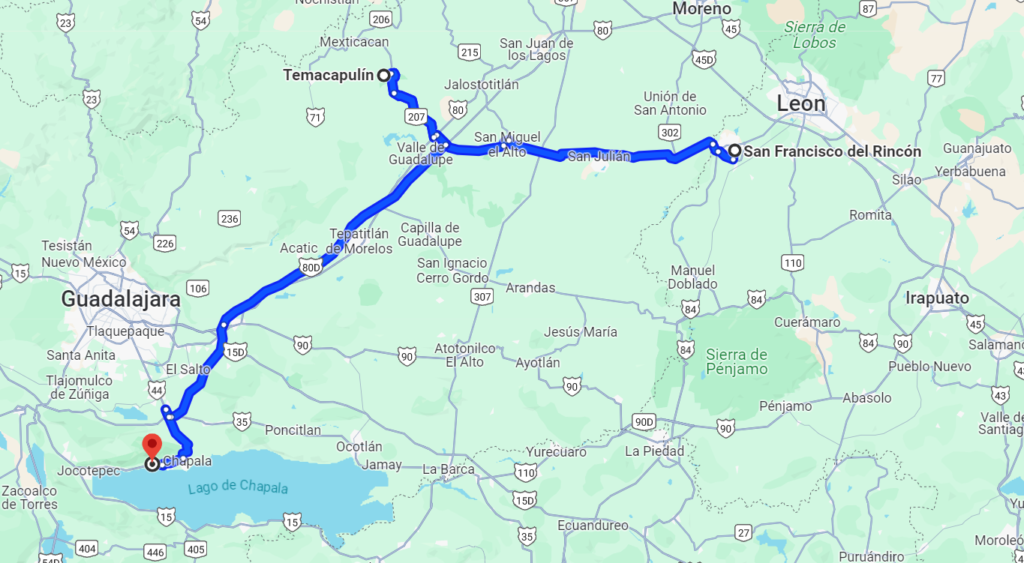
Temacapulin
Our twentieth and last Pueblo Mágico on our trip (other than Ajijic) is Temacapulin, and now we’ll be back in our home state of Jalisco. Temacapulin was another of the new Pueblos Mágicos named in 2023.
This may also be the tiniest town we are visiting, with a population of just over 300 inhabitants. It is known in large part for its hot springs, but even if we don’t partake (which will be difficult with Taco in tow), it sounds like a lovely town worth a visit. The 18th-century Basílica de Nuestra Señora de los Remedios, the many colonial estates and villas, and the old pantéon will give us a few things to see.
pueblosmagicos.mexicodesconocido.com.mx/jalisco/temacapulin/
escapadas.mexicodesconocido.com.mx/temacapulin-pueblo-magico-el-sobreviviente-de-una-inundacion/
Ajijic
And Day Ten is the final day of our road trip. We should be back in Ajijic by mid-afternoon.
I’m exhausted just thinking and writing about it. I also realize that it would have been good to have a few more days, mostly to spend in the Sierra Gorda and Huasteca Potosina. But I’m looking forward to each and every bit of this trip and all the things to see, including scenic beauty, history, good local food, crafts, art, and architecture.
I’ll try to find time to do some blogging along the way. And I’ll certainly post lots of photos. I hope you’re almost as excited as I am!

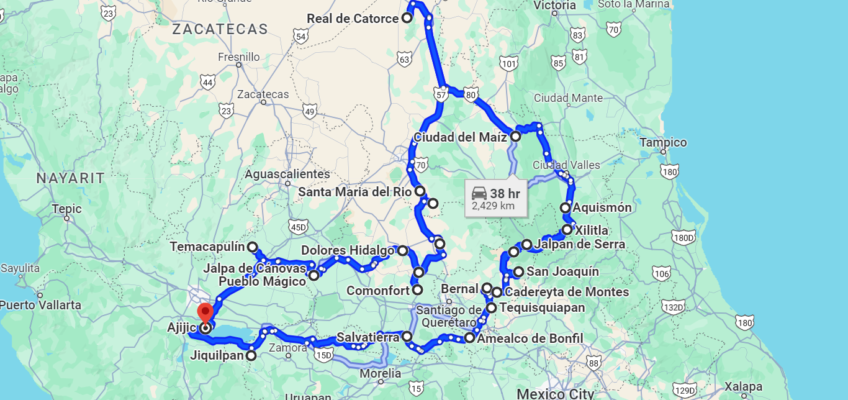
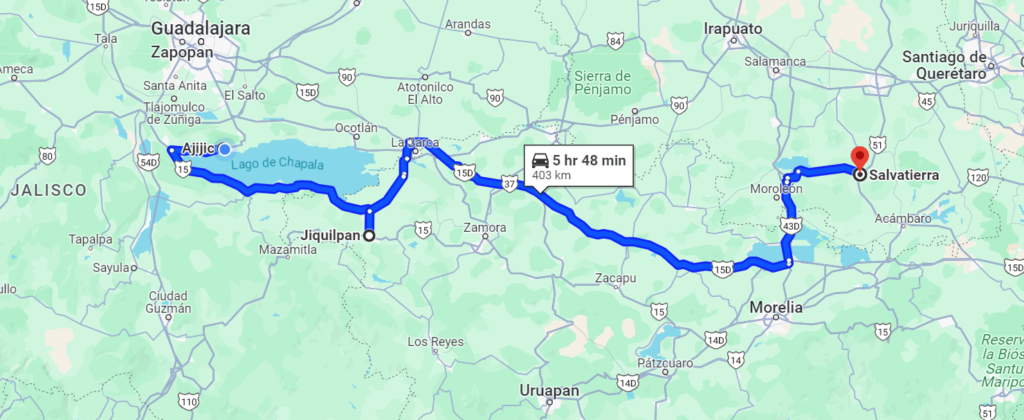






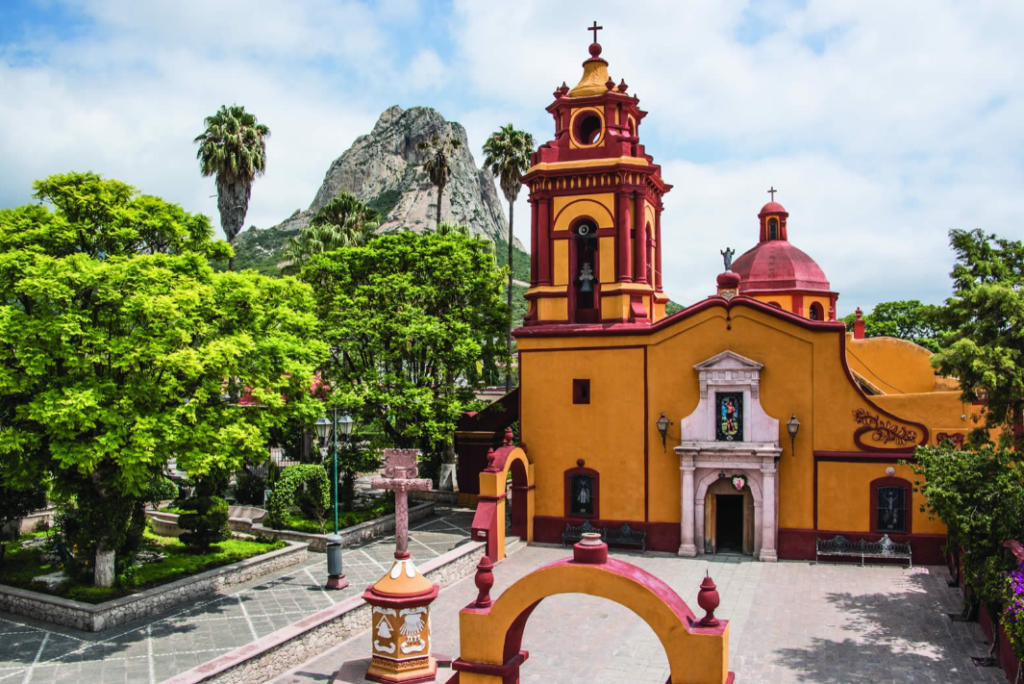
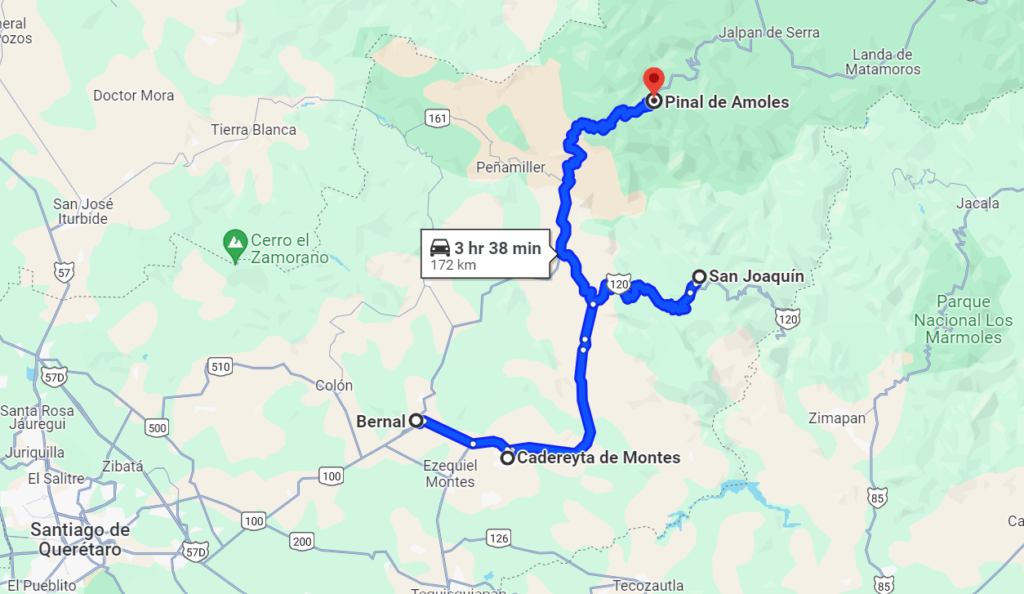



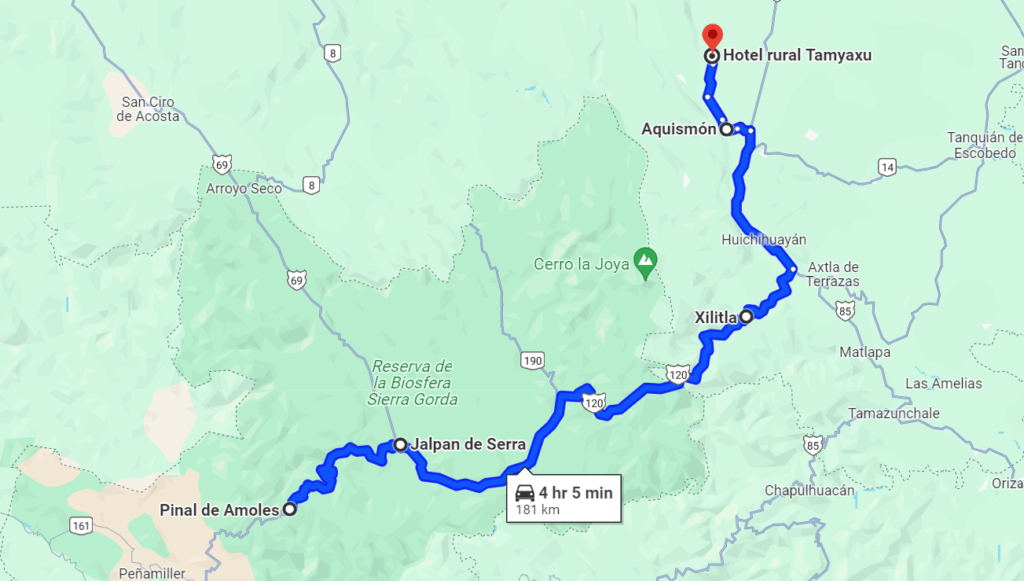
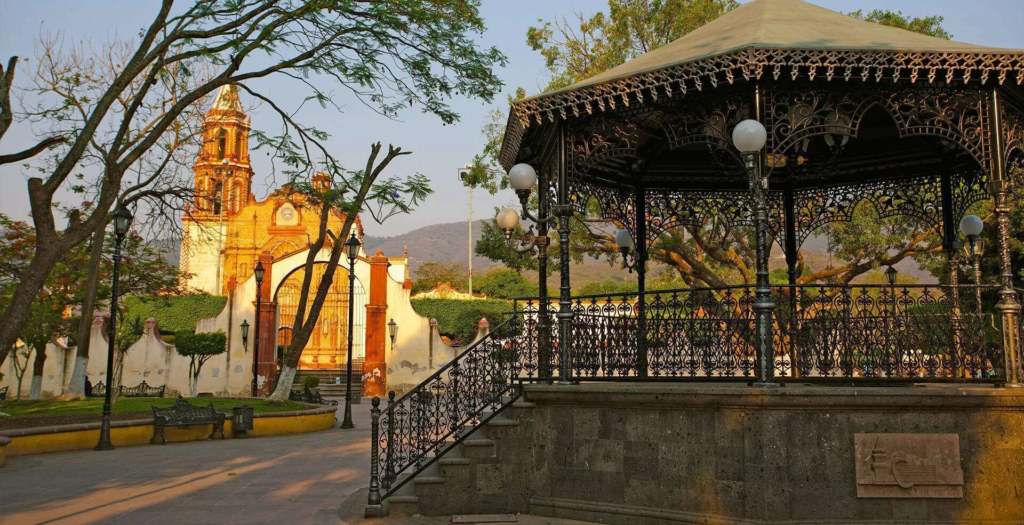


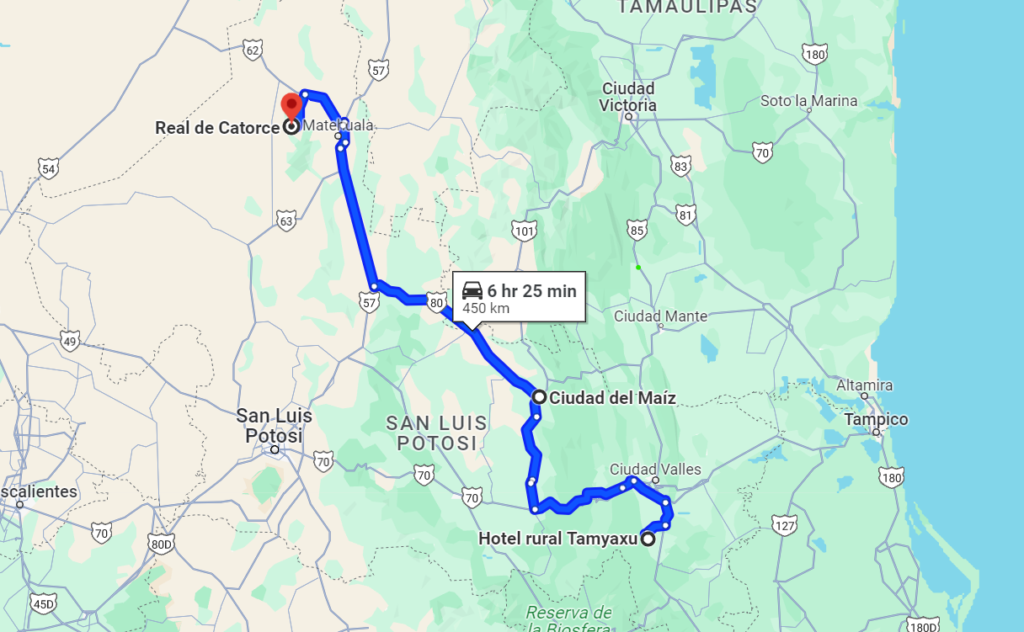






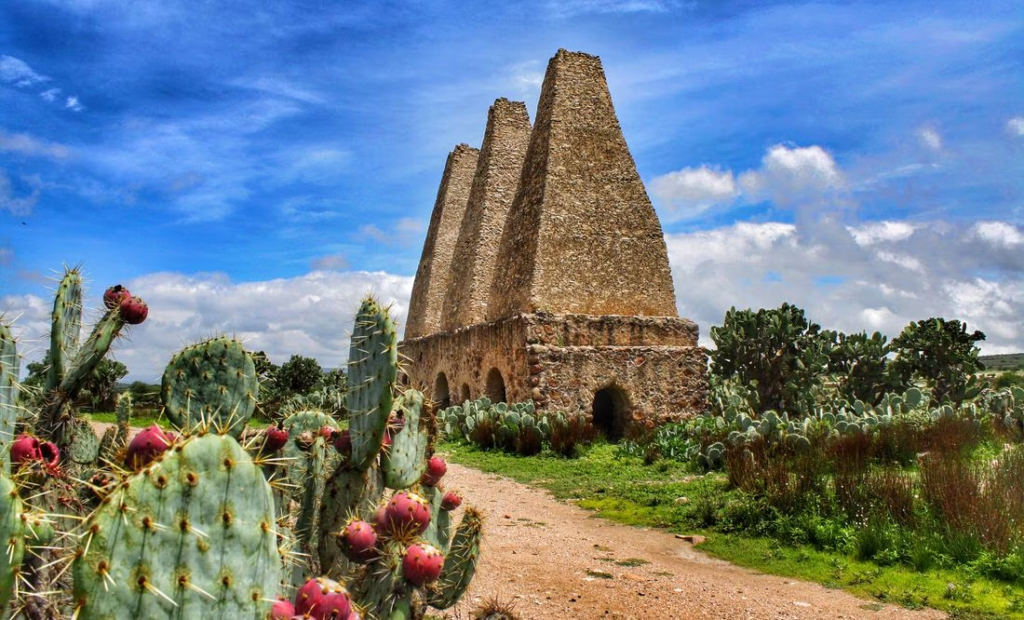







Timothy Welch
OMG! This road trip looks like so much fun. I can’t wait to read the journal entries and see the photos. Have a great time.
Lane
Thanks Tim! I hope I have time to write about this trip as we go! It feels like it’s going to be jam packed.
pesosinmypocket
love this it looks so fun! my boyfriend lives out near Amealco, I’m so happy you included it!
Lane
Thank you for reading!